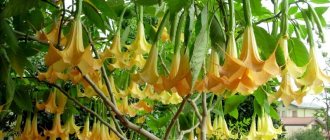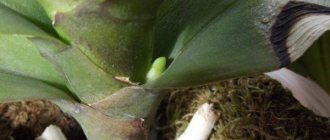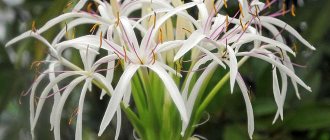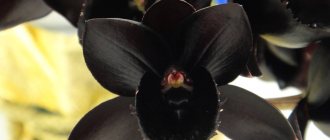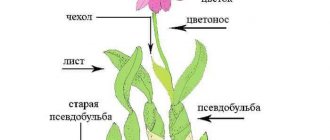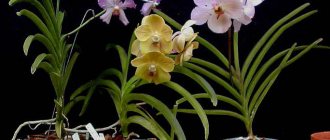Judging by the appearance of the orchid, the plant is already quite mature, and its root system is thoroughly rotten. As a result, the leaves began to wither and turn yellow, since the rotted roots were no longer able to provide them with moisture. However, it is quite possible to save the flower, because the upper part of the main root seems to be still alive. Upon closer inspection, dormant buds should be visible.
To resuscitate an orchid, it is necessary to carry out a number of manipulations:
- thoroughly clean the plant from rotten residues;
- process the flower;
- prepare the pot and substrate;
- plant an orchid.
Removing rotten parts of an orchid
Before replanting a flower, you should remove not only the dried roots. The photo shows that the main root has also rotted - it is black. Using sharp scissors or a knife, cut off the entire blackened part of the root to the beginning of living (green) tissue. Only hard, elastic, light-colored roots with a green tint can be left.
Before pruning, tools must be disinfected.
Yellowed leaves also need to be removed: cut the leaf lengthwise with scissors and gently pull it in different directions at the base.
Orchid processing
After trimming damaged tissue, rinse the remaining root system in a weak solution of potassium permanganate. Wipe the leaves themselves with a damp cloth soaked in the same solution. Next, sprinkle all cut areas with activated carbon. You can use regular cinnamon for these purposes.
To stimulate root formation, experienced gardeners recommend soaking the roots of the plant before planting in a solution of the drug Epin (1 drop per liter of water).
Now you need to let the orchid dry thoroughly. The drying time should be at least 3 hours, and it is even better to carry out all the preparatory work in the evening and leave the plant overnight. During this time, all moisture will evaporate, including from hard-to-reach places, such as an outlet. In addition, the cut areas will tighten a little.
Why do orchids need potassium permanganate?
Dark brown crystals are used to obtain a solution that has a positive effect on most plants. Potassium permanganate for orchids is used in the following cases:
- To combat insects such as white midges. But this product is not intended for pest control, so its effectiveness is extremely low.
- For disinfecting soil under flowers. The drug solution eliminates the risk of late blight, gray rot, powdery mildew and other infectious lesions. When frequently watering the soil with potassium permanganate, the possibility of drying of the roots must be taken into account.
- To accelerate plant growth. The drug is mixed with boric acid and the resulting mixture is watered on the bushes. This procedure accelerates the appearance of ovaries and the development of buds. Suitable for berry bushes, indoor tomatoes, cucumbers, several types of flowers and other similar plants.
- To clean the underground part of flowers from rot that develops on the bulbs. If cleaned orchid roots are treated with a weak solution of the drug for 10-15 minutes, then all harmful fungi and bacteria will die. This procedure is carried out when transplanting a plant into another soil.
- To stimulate the growth of cuttings or seeds, which are soaked in the solution for half an hour. At the same time, they are disinfected. Not all indoor plants need this procedure.
- As a top dressing if the flower shows signs of potassium deficiency. This procedure must be performed carefully, otherwise the increased concentration of metal can burn the leaves and damage the root system.
Potassium permanganate for indoor flowers.
Potassium permanganate can be used to disinfect bouquets created from cut field or house plants. This will allow the flowers to stay in the vase for 3-4 days longer.
Planting an orchid
Place a drainage layer at the bottom of the pot - it will prevent the roots from rotting due to stagnant water. Sprinkle a little dried substrate on top and place the orchid on it. Carefully place the aerial roots inside the pot. If there are particularly long ones that do not fit into the flowerpot, there is no need to forcibly bend or break them. Let them remain on the surface. Cover the roots placed in the pot with substrate.
To speed up the process of formation of new roots, place the pot with the plant under a cover to avoid rapid evaporation of moisture and to maintain the same air temperature throughout the day. During the first days, it is enough to wipe the leaves with a damp sponge; there is no need to water yet. In the future, watering should be carried out as usual.
Reanimation of an orchid with rotten roots - video
A solution of potassium manganese is a substance that disinfects the soil and stimulates the growth of orchids.
But in order for everything to grow well, you must be able to correctly create a solution and carry out the necessary processing . If done incorrectly, you can burn the plant's root system.
Next, we will look at whether it is possible to treat an orchid with potassium permanganate and how to do it correctly.
Is it possible to water an orchid with potassium permanganate?
Disinfectant and nutritional properties
If a solution of potassium permanganate is made in the correct proportion, it will help avoid diseases and pests that may appear on the plant. But when using manganese, it is necessary to dilute it as correctly as possible in accordance with the requirements and not water it every time. Since frequent use can dry out the root mass of the plant.
It is very important to prepare a solution of the correct concentration.
Reasons for use
Sometimes, if not properly cared for, a plant develops problems with its root mass. So, with excessive watering, the roots begin to rot. The plant requires replanting with a complete replacement of the soil. And at the moment when the flower is taken out of the old soil, it will need to be inspected and all rotting places removed.
Preparation of the solution
It's easy enough:
- carefully open the bottle of dry potassium permanganate over a newspaper;
- hands must be dry;
- With the tip of a dry knife, literally take a couple of granules and dilute them in warm water ;
- the granules must dissolve completely , since those remaining undissolved will burn the roots or leaves of the plant;
- if the solution turns out to be too pink, then it is diluted to the desired concentration with warm boiled water.
Potassium permanganate granules should completely dissolve in water.
How to make soap solution for orchids?
A solution based on laundry soap helps against aphids, thrips, and spider mites. It's easy to prepare. Dilute 30 grams of crushed soap in 1 liter of hot water, stir until completely dissolved. The plant is completely cooled and processed.
Interesting materials:
What can you eat at night? What can you put in the stroller? What can be fertilized with ash? What can you find out with bronchoscopy? What can you put in Smartavia hand luggage? What can you import into Tanzania? What can you take with you to the pool? What can you take on board the plane besides hand luggage? What can you ask Alice? What is more reliable: hard drive or SSD?
When orchids need revision and maintenance of the root system
Growing orchids in transparent pots is no accident. It is convenient because the condition of the roots is clearly visible through the walls. By their appearance you can determine:
- Timing of watering and fertilizing
- General health of the plant,
- The need for a transplant.
An orchid is a sensitive plant; unless necessary, it should not be moved ahead of time. But, there are circumstances in which, in addition to a planned transplant, rescue work is urgently needed. This can be determined by the following changes in the root system:
| Decay | Occurs with excessive watering and high humidity. Wet spots of white, yellow or brown color appear on the roots. The development of the disease leads to the complete death of the roots and spreads towards the ground organs. |
| Stopping growth | Typically for plants that have outgrown their pot. At the same time, the root system seems to want to jump out of its container. |
| Formation of excessive aerial roots | Happens due to poor environmental conditions or improper care. In this case, not only replanting is required, but removal of excess root mass is required. |
| Drying | A consequence of lack of moisture or fungal disease. It can also occur from depletion and compaction of the substrate. |
| Signs of pest damage | In the advanced stage, replanting with treatment with medicinal plant protection products is required. |
How to know which roots need to be cut and treated
A healthy orchid root system is covered with a special spongy substance, velamen. This integumentary tissue performs a respiratory function and also supplies plants with gaseous nutrients. Healthy roots have:
- regular cylindrical shape, the same along the entire length,
- durable turgor.
- bright green color.
It is normal for a whitish coating to appear. This means that the plant needs to be watered.
But if dots, spots or islands of yellow, brown or black color are visible on the surface of the roots, then something is wrong with the orchid.
In addition to visual analysis, you can determine the condition of the roots by touch:
- Press lightly on both sides with two fingers. A healthy process is dense and elastic.
- If sap or mucus comes out and the tissue becomes wet and slippery, the root is infected and must be removed.
To save an orchid, diseased roots need to be cut off and the plant replanted in a fresh substrate.
How to identify bad roots in an orchid?
What kind of roots should a healthy orchid have?
Photo of the root system
- Growing tip.
- Have a light green velamen color.
- Be elastic and hold its shape when pressed with two fingers.
- Dark and having a putrid odor, this is a sign that the root system is unhealthy and requires resuscitation.
Interesting materials:
How many cores are there in i3 9100f? How many cores are there in i5 9400f? How many cores are there in i7 9700k? How many cores does the i9 9900k have? How many cores does the Intel Core i5 9400f have? How many cores does Xiaomi Note 4 have? How long does EMS delivery take? How long does it take for an international transfer? How long does it take to transfer from an Alfa Bank account to a Sberbank account? How long does a swift transfer take?
Detailed instructions for pruning and treating roots before a planned transplant
All operations are performed with sterile instruments. To disinfect, the blade of a knife or pruner is treated with a disinfectant, for example, alcohol or chlorhexidine. Precaution is necessary to prevent infection of healthy tissue from diseased roots.
Trimming is done like this:
| Step 1 | Place the orchid pot in a container of water so that the substrate is well soaked. This is necessary so as not to damage the roots when removing from the pot. | |
| Step 2 | Remove the orchid from the substrate and clean it. You can finally free the roots from the soil mixture by rinsing them under running warm water. | |
| Step 3 | Carefully examine the root system from all sides. Roots with cracks, spots, spots, as well as dry and rotten ones must be pruned. | |
| Step 4 | Use a sharp knife (or garden pruning shears) to separate the infected part of the root. Make a cut 3 cm above the injury site, down to living tissue. | |
| Step 5 | To stop the flow of sap in the wound, the orchid is left for some time to dry the sections. | |
| Step 5 | When the wound dries, it is treated with a protective agent. Most often used: | |
· Activated carbon, crushed into powder.
· Powdered wood ash.
These substances will prevent infection from entering the open wound.
If replanting is necessary in case of plant disease, then treatment with fungicides is necessary after pruning.
How often should an orchid be watered?
This crop belongs to plants that are watered relatively infrequently. They accumulate water. Dense leaves allow the orchid to withstand periods of drought. The frequency of watering is affected by:
- season;
- drying speed;
- the fact whether a plant is flowering or not.
On average, they need to be watered every 3-7 days.
In summer
The natural habitats of exotics are quite arid, so they can easily tolerate high temperatures. And if there is also high humidity in the room, then these are ideal conditions for them. Watering in summer can be abundant and frequent. Can also be sprayed. Orchids thrive in humid environments.
Factors influencing summer care are:
- increased air temperature;
- high evaporation rate;
- risk of exposure to sunlight.
Important! Orchids are watered in a way that allows the soil to be thoroughly wetted. It consists mainly of wood shavings and does not immediately absorb moisture.
You can tell when there is enough liquid by the color of the roots. If they are bright green, it means there is still enough moisture inside. If they turn gray, it means the soil is dry. You can let the roots dry for a couple of days. Drought is also natural and beneficial for them, but it does not last long.
in autumn
With the beginning of autumn, watering is almost no different from summer, if the weather remains hot. It should be reduced from October. The soil will dry out more slowly. Therefore, the frequency of watering should be reduced. If in summer an orchid can be watered once every two to three days, then in autumn once a week is enough.
You should pay attention to the following indicators:
- air humidity;
- sudden changes in temperature;
- presence of drafts.
You should ensure that no water remains inside the leaf axils. Often after overhead irrigation it stagnates there. As temperatures drop, the leaves may begin to rot. Some gardeners water orchids with warm water. This is an acceptable measure, but in any case the temperature should not be higher than 40 degrees.
in winter
In winter, the substrate should be moistened even less often. Firstly, the rate of evaporation decreases. Secondly, the liquid cools, and contact of the roots with cold water for a long time is unfavorable. There is no need for frequent watering in winter, because the rate of metabolic processes decreases. The plant lives by saving energy.
It is important to ensure that:
- excess water drained from the pan;
- moisture did not stagnate inside the leaf sinuses;
- the plant was not overcooled;
- the entry of cold air through window slits was excluded.
Spraying and other measures to humidify the air are usually not necessary either. Moisture supplied once every two weeks is sufficient. If the apartment is heavily heated, the house is hot even in winter, watering should be increased according to needs. When the air temperature is below 18 degrees, it is advisable to take care of insulation.
Possible measures:
- place the pot on a sheet of foam plastic;
- place in a closed pot;
- avoid drafts.
in spring
In spring, orchids awaken. Peduncles with buds are often already formed and actively growing. This process begins at the end of February. You can now water more often. Exotics need more minerals and trace elements.
Factors influencing spring watering:
- changes in biorhythms, increased need for nutrients and water;
- peduncle growth;
- variability of weather conditions.
Therefore, from spring, watering may include fertilizing. The main thing is to avoid overdose.
Peculiarity! Orchids tolerate a lack of fertilizer much more easily. From “feeding for slaughter” they can disappear.
Air temperatures in spring can vary from cold to almost summer weather. Therefore, it is worth moistening the soil based on individual conditions.
To analyze soil moisture, you can do a number of simple techniques:
- lift the pot, assess whether it is heavy;
- take a few elements of soil out of the pot and touch them;
- immerse the match 3 cm into the ground.
It should be taken into account that the humidity of the substrate may not be uniform. This depends on the quality of watering and the location of the roots.

